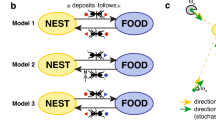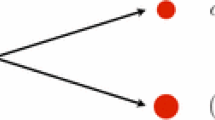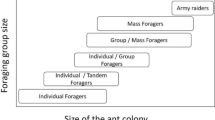Abstract
Ant species on a “high evolutionary level” have evolved chemical recruitment systems such as mass recruitment or quality recruitment. The recruitment process from the nest to a food source may be damped by crowding effects at the source. For four patterns of behavior (mass/quality recruitment; with/without damping) we study mathematical models for the time development of the quantity of food at the source. Each of the models can be reduced to a second order time-delayed differential equation which will be studied in the equivalent form of a first order (nonlinear) functional differential equation. We discuss the complete exploitation of a given source. In case of mass recruitment there possibly remains a threshold quantity of food not worth exploiting. However, every source will be exploited completely (in finite time) provided that the volatility of the trail pheromone is small compared with the exploitation activities of the colony and the distance from the nest to the source. In addition, for the damped models the “capacity” of the crowded source must be large compared with the initial quantity of food offered. The efficiency of the exploitation activities of some species allows conclusions on their evolutionary development.
Similar content being viewed by others
References
Bossert, W. H., Wilson, E. O.: The analysis of olfactory communication among animals. J. Theor. Biol. 5, 443–469 (1963)
Dumpert, K.: Das Sozialleben der Ameisen. Berlin: Parey 1978
Hingston, R. W. G.: Instinct and intelligence. New York: Macmillan 1929
Hölldobler, B.: Ethological aspects of chemical communication in ants. Adv. Stud. Behav. 8, 75–115 (1978)
Jaffe, K.: Theoretical analysis of the communication system for chemical mass recruitment in ants. J. Theor. Biol. 84, 589–609 (1980)
Jaffe, K.: Negentropy and the evolution of chemical recruitment in ants (Hymenoptera: Formicidae). J. Theor. Biol. 106, 587–604 (1984)
Jaffe, K., Howse, P. E.: The mass recruitment system of the leaf cutting ant Atta cephalotes (L). Animal Behav. 27, 930–939 (1979)
Jaffe, K., Villegas, G., Colmenares, O., Puche, H., Zabala, N. A., Alvarez, M. I., Navarro, J. G., Pino, E.: Two different decision-making systems in recruitment to food in ant societies. Behaviour 92 (Part 1–2), 9–21 (1985)
Körner (née Orth), B.: Die mathematische Modellierung von verschiedenen Rekrutierungssystemen bei der chemischen Kommunikation zwischen Insekten. Diplomarbeit, Mathematisches Institut der Universität zu Köln (1985)
Okubo, A.: Difiusion in ecological problems: mathematical models. Berlin Heidelberg New York: Springer 1980
Stanley, B. H., Hummel, H. E., Ruesing, W. G.: Estimating maximal horizontal area of pheromone plumes. J. Chem. Ecol. 11, 1129–1146 (1985)
Traniello, J. F. A.: Recruitment behaviour, orientation, and the organization of foraging in the carpenter ant Camponotus pennsylvanicus DeGeer (Hymenoptera: Formicidae). Behav. Ecol. Socio-biol. 2, 61–79 (1977)
Weyer, J.: A mathematical model for chemical mass recruitment of ants. J. Math. Biol. 21, 307–315 (1985)
Weyer, J.: Diffusionsphänomene bei der chemischen Kommunikation zwischen Insekten. In: Kempf, A. M., Wille, F. (eds.) Mathematische Modellierung—ein Arbeitsbuch für Seminare New York: McGraw-Hill 1986
Wilson, E. O.: Chemical communication among workers of the fire ant Solenopsis saevissima. Animal Behav. 10, 134–164 (1962)
Wilson, E. O.: The insect societies. London: The Belknap Press of Harvard University Press (1971/79)
Author information
Authors and Affiliations
Rights and permissions
About this article
Cite this article
Körner, B., Weyer, J. Mathematical models for some types of chemical information systems. J. Math. Biology 25, 275–288 (1987). https://doi.org/10.1007/BF00276437
Received:
Revised:
Issue Date:
DOI: https://doi.org/10.1007/BF00276437




